Upgrading from an Intel Core i7-2600K: Testing Sandy Bridge in 2019
by Ian Cutress on May 10, 2019 10:30 AM EST- Posted in
- CPUs
- Intel
- Sandy Bridge
- Overclocking
- 7700K
- Coffee Lake
- i7-2600K
- 9700K
Sandy Bridge: Outside the Core
With the growth of multi-core processors, managing how data flows between the cores and memory has been an important topic of late. We have seen a variety of different ways to move the data around a CPU, such as crossbars, rings, meshes, and in the future, completely separate central IO chips. The battle of the next decade (2020+), as mentioned previously here on AnandTech, is going to the battle of the interconnect, and how it develops moving forward.
What makes Sandy Bridge special in this instance is that it was the first consumer CPU from Intel to use a ring bus that connects all the cores, the memory, the last level cache, and the integrated graphics. This is still a similar design to the eight core Coffee Lake parts we see today.
The Ring Bus
With Nehalem/Westmere all of the cores had their own private path to the last level (L3) cache. That’s roughly 1000 wires per core, and more wires consume more power as well as being more difficult to implement the more you have. The problem with this approach is that it doesn’t work well as you scale up in things that need access to the L3 cache.
As Sandy Bridge adds a GPU and video transcoding engine on-die that share the L3 cache, rather than laying out more wires to the L3, Intel introduced a ring bus.
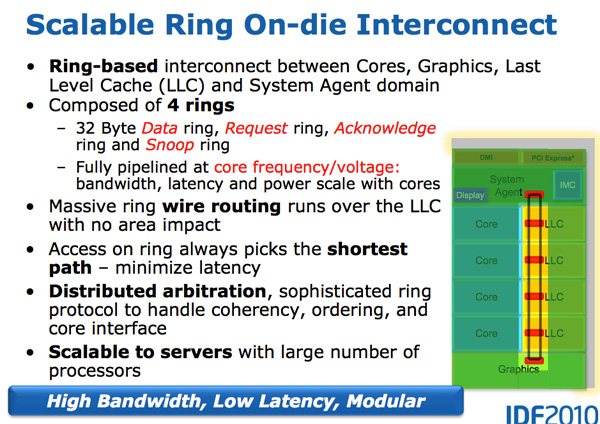
Architecturally, this is the same ring bus used in Nehalem EX and Westmere EX. Each core, each slice of L3 (LLC) cache, the on-die GPU, media engine and the system agent (fancy word for North Bridge) all have a stop on the ring bus. The bus is made up of four independent rings: a data ring, request ring, acknowledge ring and snoop ring. Each stop for each ring can accept 32-bytes of data per clock. As you increase core count and cache size, your cache bandwidth increases accordingly.
Per core you get the same amount of L3 cache bandwidth as in high end Westmere parts - 96GB/s. Aggregate bandwidth is 4x that in a quad-core system since you get a ring stop per core (384GB/s).
This means that L3 latency is significantly reduced from around 36 cycles in Westmere to 26 - 31 cycles in Sandy Bridge, with some variable cache latency as it depends on what core is accessing what slice of cache. Also unlike Westmere, the L3 cache now runs at the core clock speed - the concept of the un-core still exists but Intel calls it the “system agent” instead and it no longer includes the L3 cache. (The term ‘un-core’ is still in use today to describe interconnects.)
With the L3 cache running at the core clock you get the benefit of a much faster cache. The downside is the L3 underclocks itself in tandem with the processor cores as turbo and idle modes come into play. If the GPU needs the L3 while the CPUs are downclocked, the L3 cache won’t be running as fast as it could had it been independent, or the system has to power on the core and consume extra power.
The L3 cache is divided into slices, one associated with each core. As Sandy Bridge has a fully accessible L3 cache, each core can address the entire cache. Each slice gets its own stop and each slice has a full cache pipeline. In Westmere there was a single cache pipeline and queue that all cores forwarded requests to, but in Sandy Bridge it’s distributed per cache slice. The use of ring wire routing means that there is no big die area impact as more stops are added to the ring. Despite each of the consumers/producers on the ring get their own stop, the ring always takes the shortest path. Bus arbitration is distributed on the ring, each stop knows if there’s an empty slot on the ring one clock before.
The System Agent
For some reason Intel stopped using the term un-core in SB, and for Sandy Bridge it’s called the System Agent. (Again, un-core is now back in vogue for interconnects, IO, and memory controllers). The System Agent houses the traditional North Bridge. You get 16 PCIe 2.0 lanes that can be split into two x8s. There’s a redesigned dual-channel DDR3 memory controller that finally restores memory latency to around Lynnfield levels (Clarkdale moved the memory controller off the CPU die and onto the GPU).
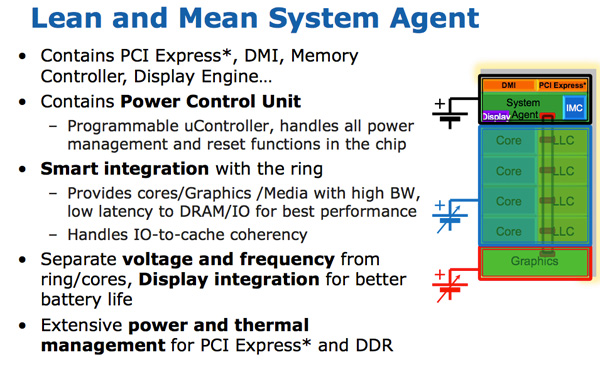
The SA also has the DMI interface, display engine and the PCU (Power Control Unit). The SA clock speed is lower than the rest of the core and it is on its own power plane.
Sandy Bridge Graphics
Another large performance improvement on Sandy Bridge vs. Westmere is in the graphics. While the CPU cores show a 10 - 30% improvement in performance, Sandy Bridge graphics performance is easily double what Intel delivered with pre-Westmere (Clarkdale/Arrandale). Despite the jump from 45nm to 32nm, SNB graphics improves through a significant increase in IPC.
The Sandy Bridge GPU is on-die built out of the same 32nm transistors as the CPU cores. The GPU is on its own power island and clock domain. The GPU can be powered down or clocked up independently of the CPU. Graphics turbo is available on both desktop and mobile parts, and you get more graphics turbo on Sandy Bridge.
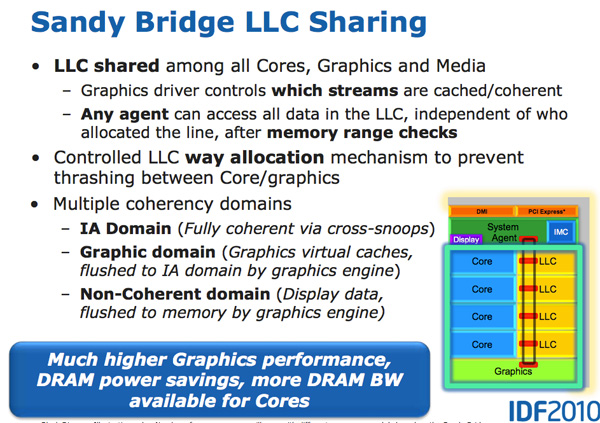
The GPU is treated like an equal citizen in the Sandy Bridge world, it gets equal access to the L3 cache. The graphics driver controls what gets into the L3 cache and you can even limit how much cache the GPU is able to use. Storing graphics data in the cache is particularly important as it saves trips to main memory which are costly from both a performance and power standpoint. Redesigning a GPU to make use of a cache isn’t a simple task.
SNB graphics (internally referred to as Gen 6 graphics) makes extensive use of fixed function hardware. The design mentality was anything that could be described by a fixed function should be implemented in fixed function hardware. The benefit is performance/power/die area efficiency, at the expense of flexibility.
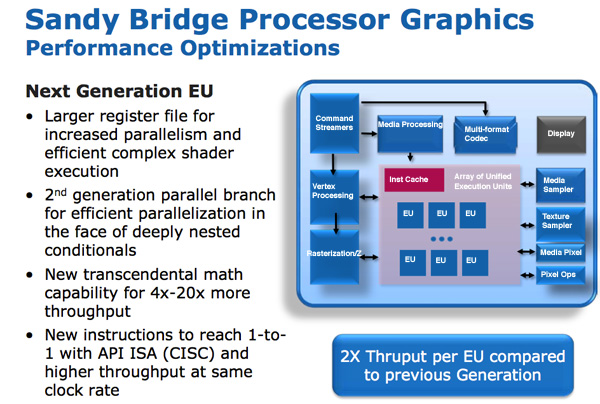
The programmable shader hardware is composed of shaders/cores/execution units that Intel calls EUs. Each EU can dual issue picking instructions from multiple threads. The internal ISA maps one-to-one with most DirectX 10 API instructions resulting in a very CISC-like architecture. Moving to one-to-one API to instruction mapping increases IPC by effectively increasing the width of the EUs.
There are other improvements within the EU. Transcendental math is handled by hardware in the EU and its performance has been sped up considerably. Intel told us that sine and cosine operations are several orders of magnitude faster now than they were in pre-Westmere graphics.
In previous Intel graphics architectures, the register file was repartitioned on the fly. If a thread needed fewer registers, the remaining registers could be allocated to another thread. While this was a great approach for saving die area, it proved to be a limiter for performance. In many cases threads couldn’t be worked on as there were no registers available for use. Intel moved from 64 to 80 registers per thread and finally to 120 for Sandy Bridge. The register count limiting thread count scenarios were alleviated.
At the time, all of these enhancements resulted in 2x the instruction throughput per EU.

Sandy Bridge vs. NVIDIA GeForce 310M Playing Starcraft 2
At launch there were two versions of Sandy Bridge graphics: one with 6 EUs and one with 12 EUs. All mobile parts (at launch) will use 12 EUs, while desktop SKUs may either use 6 or 12 depending on the model. Sandy Bridge was a step in the right direction for Intel, where integrated graphics were starting to become a requirement in anything consumer related, and Intel would slowly start to push the percentage of die area dedicated to GPU. Modern day equivalent desktop processors (2019) have 24 EUs (Gen 9.5), while future 10nm CPUs will have ~64 EUs (Gen11).
Sandy Bridge Media Engine
Sitting alongside the GPU is Sandy Bridge’s Media processor. Media processing in SNB is composed of two major components: video decode, and video encode.
The hardware accelerated decode engine is improved from the current generation: the entire video pipeline is now decoded via fixed function units. This is contrast to Intel’s pre-SNB design that uses the EU array for some video decode stages. As a result, Intel claims that SNB processor power is cut in half for HD video playback.

The video encode engine was a brand new addition to Sandy Bridge. Intel took a ~3 minute 1080p 30Mbps source video and transcoded it to a 640 x 360 iPhone video format. The total process took 14 seconds and completed at a rate of roughly 400 frames per second.

The fixed function encode/decode mentality is now pervasive in any graphics hardware for desktops and even smartphones. At the time, Sandy Bridge was using 3mm2 of the die for this basic encode/decode structure.
New, More Aggressive Turbo
Lynnfield was the first Intel CPU to aggressively pursue the idea of dynamically increasing the core clock of active CPU cores while powering down idle cores. The idea is that if you have a 95W TDP for a quad-core CPU, but three of those four cores are idle, then you can increase the clock speed of the one active core until you hit a turbo limit.
In all current generation processors the assumption is that the CPU reaches a turbo power limit immediately upon enabling turbo. In reality however, the CPU doesn’t heat up immediately - there’s a period of time where the CPU isn’t dissipating its full power consumption - there’s a ramp.
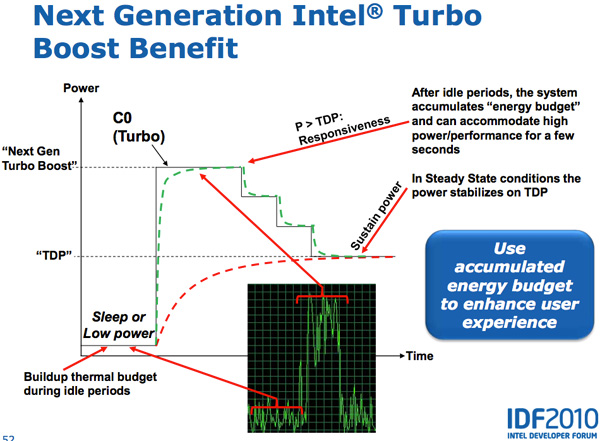
Sandy Bridge takes advantage of this by allowing the PCU to turbo up active cores above TDP for short periods of time (up to 25 seconds). The PCU keeps track of available thermal budget while idle and spends it when CPU demand goes up. The longer the CPU remains idle, the more potential it has to ramp up above TDP later on. When a workload comes around, the CPU can turbo above its TDP and step down as the processor heats up, eventually settling down at its TDP. While SNB can turbo up beyond its TDP, the PCU won’t allow the chip to exceed any reliability limits.
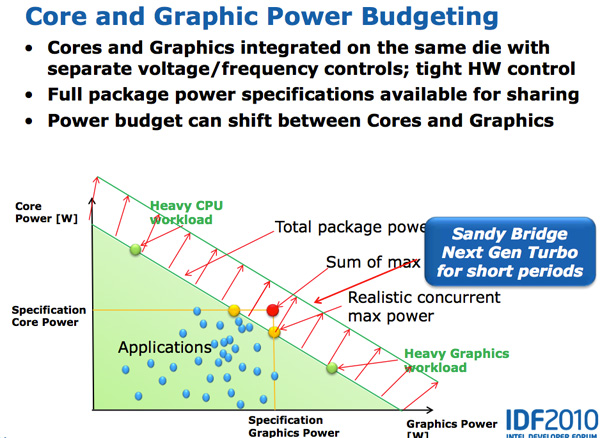
Both CPU and GPU turbo can work in tandem. Workloads that are more GPU bound running on SNB can result in the CPU cores clocking down and the GPU clocking up, while CPU bound tasks can drop the GPU frequency and increase CPU frequency. Sandy Bridge as a whole was a much more dynamic of a beast than anything that’s come before it.










213 Comments
View All Comments
StrangerGuy - Saturday, May 11, 2019 - link
One thing I want to point out that modern games are far less demanding relative to the CPU versus games in the 90s. If anyone thinks their 8 year old Sandy Bridge quad is having it sort of rough today, they are probably not around to remember running Half-Life comfortably above 60 FPS at least needed a CPU that was released 2 years later.versesuvius - Saturday, May 11, 2019 - link
There is a point in every Windows OS user computer endeavors, that they start playing less and less games, and at about the same time start foregoing upgrades to their CPU. They keep adding ram and hard disk space and maybe a new graphic card after a couple of years. The only reason that such a person that by now has completely stopped playing games may upgrade to a new CPU and motherboard is the maximum amount of RAM that can be installed on their motherboard. And with that really comes the final PC that such a person may have in a long, long time. Kids get the latest CPU and soon will realize the law of diminishing returns, which by now is gradually approaching "no return", much faster than their parents. So, in perhaps ten years there will be no more "Tic", or "Toc" or Cadence or Moore's law. There be will computers, baring the possibility that dumb terminals have replaced PCs, that everybody knows what they can expect from. No serendipity there for certain.Targon - Tuesday, May 14, 2019 - link
The fact that you don't see really interesting games showing up all that often is why many people stopped playing games in the first place. Many people enjoyed the old adventure games with puzzles, and while action appeals to younger players, being more strategic and needing to come up with different approaches in how you play has largely died. Interplay is gone, Bullfrog, Lionhead....On occasion something will come out, but few and far between.Games for adults(and not just adult age children who want to play soldier on the computer) are not all that common. I blame EA for much of the decline in the industry.
skirmash - Saturday, May 11, 2019 - link
I still have an i7-2600 in an old Dell based upon an H67 chipset. I was thinking about using it as a server and updating the board to get updated connectivity. updating the board and using it as a server. Z77 chipset would seem to be the way to go although getting a new board with this chipset seems expensive unless I go used. Anyone any thoughts on this - whether its worthwhile etc or a cost effective way to do it?skirmash - Saturday, May 11, 2019 - link
Sorry for the typos but I hope you get the sentiment.Tunnah - Saturday, May 11, 2019 - link
Oh wow this is insane timing, I'm actually upgrading from one of these and have had a hard time figuring out what sort of performance upgrade I'd be getting. Much appreciated!Tunnah - Saturday, May 11, 2019 - link
I feel like I can chip in a perspective re: gaming. While your benchmarks show solid average FPS and all that, they don't show the quality of life that you lose by having an underpowered CPU. I game at 4K, 2700k (4.6ghz for heat&noise reasons), 1080Ti, and regularly can't get 60fps no matter the settings, or have constant grame blips and dips. This is in comparison to a friend who has the same card but a Ryzen 1700XNewer games like Division 2, Assassin's Creed Odyssey, and as shown here, Shadow Of The Romb Raider, all severely limit your performance if you have an older CPU, to the point where getting a constant 60fps is a real struggle, and benchmarks aside, that's the only benchmark the average user is aiming for.
I also have 1333mhz RAM, which is just a whole other pain! As more and more games move into giant open world games and texture streaming and loading is happening in game rather than on loading screens, having slow RAM really affects your enjoyment.
I'm incredibly grateful for this piece btw, I'm actually moving to Zen2 when it comes out, and I gotta say, I've not been this excited since..well, Sandy Bridge.
Death666Angel - Saturday, May 11, 2019 - link
"I don’t think I purchased a monitor bigger than 1080p until 2012."Wow, really? So you were a CRT guy before that? How could you work on those low res screens all the time?! :D I got myself a 1200p 24" monitor once they became affordable in early 2008 (W2408hH). Had a 1280x1024 19" before that and it was night and day, sooo much better.
PeachNCream - Sunday, May 12, 2019 - link
Still running 1366x768 on my two non-Windows laptops (HP Steam 11 and Dell Latitude e6320) and it okay. My latest, far less uses Windows gaming system has a 14 inch panel running 1600x900. Its a slight improvement, but I could live without it. The old Latitude does all my video production work so though I could use a few more pixels, it isn't the end of the world as is. The laptop my office issued is a HP Probook 640 G3 so it has a 14 inch 1080p panel which to have to scale at 125% to actually use so the resolution is pretty much pointless.PeachNCream - Sunday, May 12, 2019 - link
Ugh, phone auto correct...I really need to look over anything I type on a phone more closely. I feel like I'm reading comment by a non-native English speaker, but its me. How depressing.